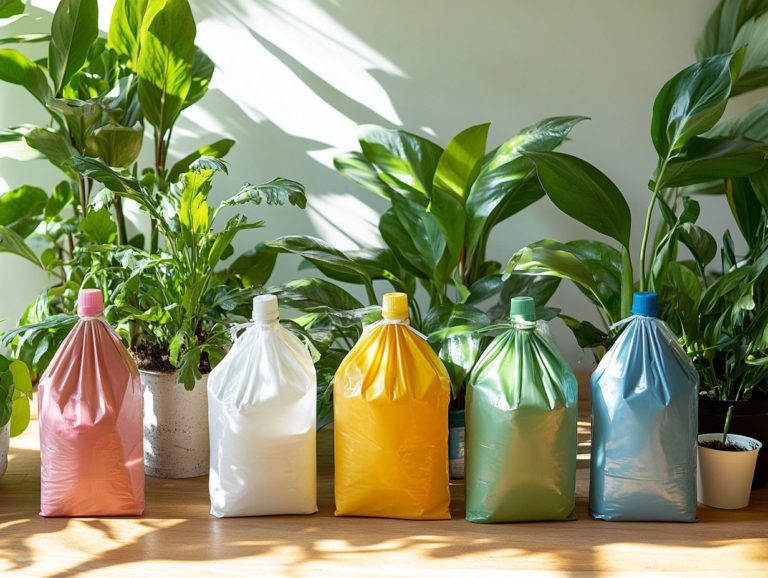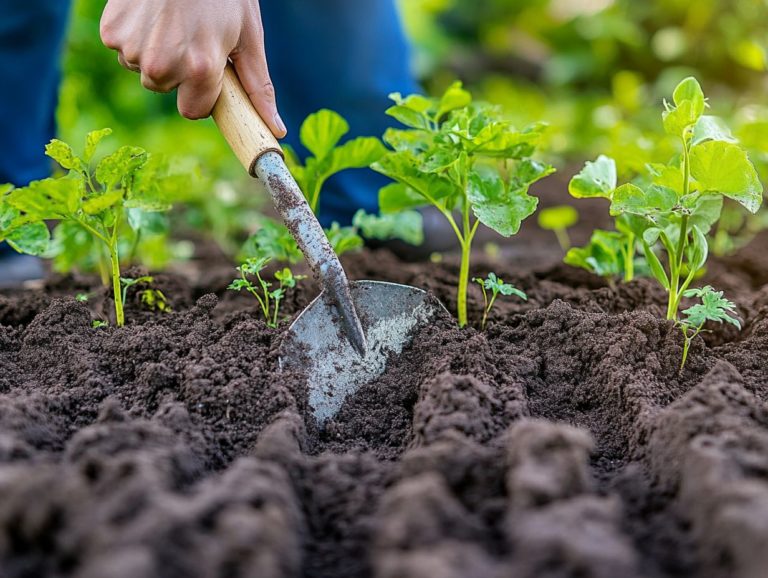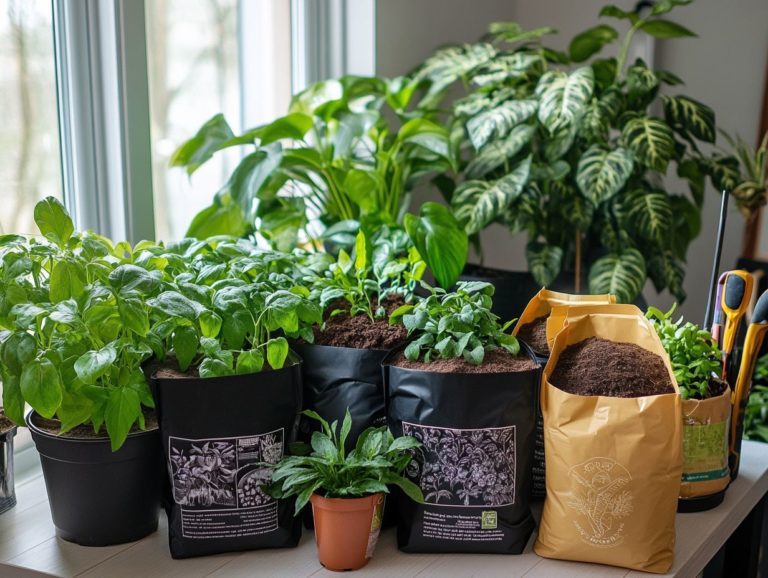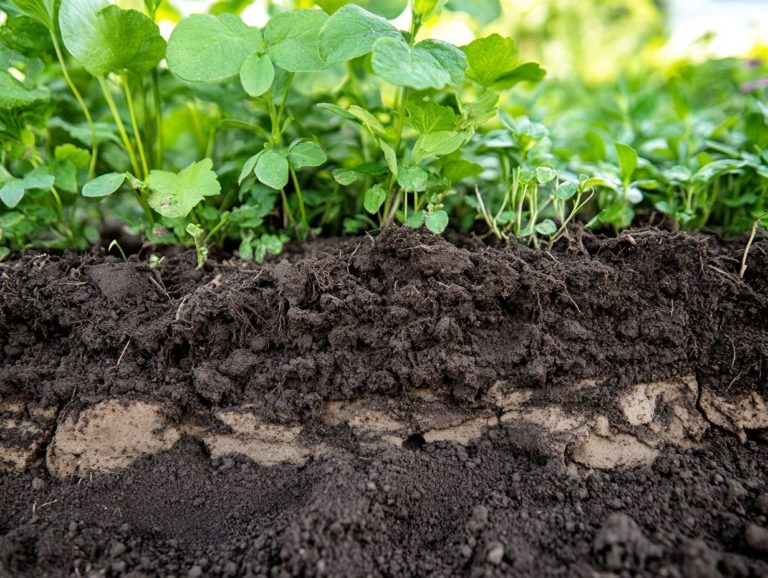10 Tips for Fertilizing Indoor Plants
Fertilizing indoor plants may seem overwhelming, but with the right knowledge and approach, you can cultivate a flourishing green oasis in your home gardening. Get ready to transform your indoor gardening experience into something extraordinary!
This guide presents 10 essential tips on how to grasp your plants’ nutrient needs, select the appropriate fertilizers, and apply them with precision.
From identifying the signs of over-fertilization to exploring organic fertilizers, you ll discover vital practices that foster healthy growth.
Contents
- Key Takeaways:
- 1. Know Your Plant’s Nutrient Needs
- 2. Choose the Right Fertilizer
- 3. Dilute Liquid Fertilizers
- 4. Use Slow-Release Fertilizers
- 5. Apply Fertilizer Sparingly
- 6. Follow the Recommended Application Schedule
- 7. Avoid Fertilizing Newly Transplanted Plants
- 8. Fertilize During the Plant’s Active Growth Period
- 9. Water Plants Before and After Fertilizing
- 10. Use Organic Fertilizers
- What Are the Signs of Overfertilization?
- How Can You Revive an Overfertilized Plant?
- What Are the Benefits of Using Organic Fertilizers?
- How Often Should You Fertilize Indoor Plants?
- Can You Make Your Own Fertilizer at Home?
- What Are the Different Types of Fertilizers and Their Uses?
- What Are Some Common Mistakes to Avoid When Fertilizing Indoor Plants?
- What Are Some Natural Alternatives to Chemical Fertilizers?
- How Can You Tell If Your Indoor Plant Needs Fertilizer?
- What Are the Nutrients Essential for Indoor Plant Growth?
- Frequently Asked Questions
- What are the benefits of fertilizing indoor plants?
- When is The Best Time to Fertilize Indoor Plants?
- How often should I fertilize my indoor plants?
- Can I use outdoor plant fertilizer on indoor plants?
- What kind of fertilizer should I use for my indoor plants?
- Are there any tips for using fertilizer on indoor plants?
Key Takeaways:
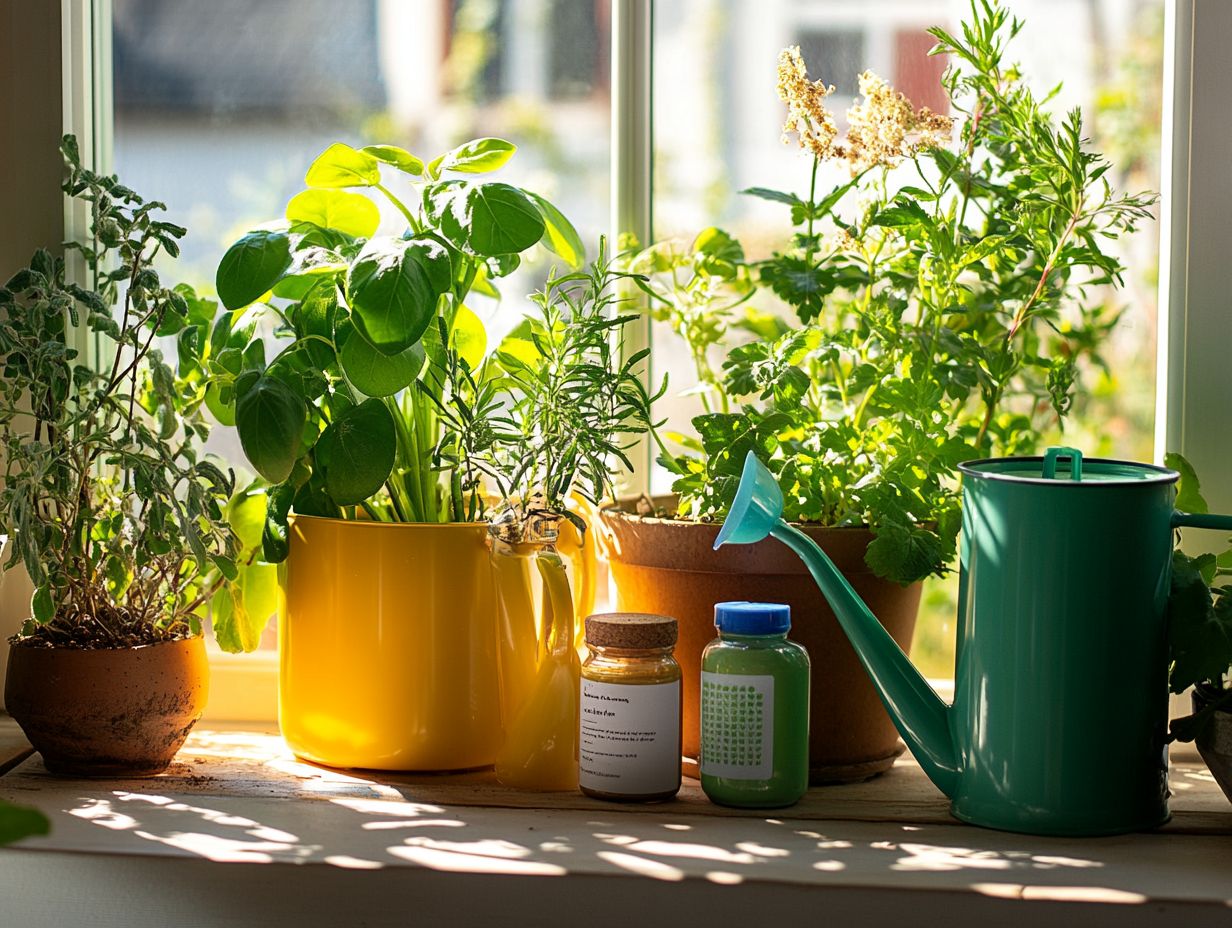
- Understand your indoor plants’ nutrient needs to select the right fertilizer.
- Dilute liquid fertilizers and use slow-release fertilizers to avoid over-fertilization.
- Apply fertilizer sparingly and during the plant’s active growth period, while avoiding newly transplanted plants.
1. Know Your Plant’s Nutrient Needs
Understanding your houseplants’ nutrient needs is crucial for maintaining their health and fostering robust growth. Each type of plant be it Alocasia, Philodendron, or orchids has specific requirements for essential nutrients like nitrogen (N), phosphorus (P), and potassium (K), together called NPK. By properly assessing these nutrient needs, you can achieve successful indoor gardening and enjoy flourishing potted plants.
This tailored approach ensures that every indoor plant receives the right balance for its unique growth stage. For example, a lush, leafy plant may demand higher nitrogen levels to promote vibrant foliage, while flowering species often thrive on increased phosphorus to enhance their blooms. Recognizing signs of nutrient deficiencies is equally important; yellowing leaves may signal a nitrogen shortage, whereas lackluster flowering could indicate insufficient phosphorus.
By staying attentive to these indicators, you can fine-tune your care routine, applying the right fertilizers and amending soil mixtures to keep your indoor garden thriving.
2. Choose the Right Fertilizer
Selecting the right fertilizer is crucial for ensuring your indoor plants receive the essential nutrients they need for optimal health and development. With a variety of options at your fingertips, ranging from organic fertilizers like compost tea to synthetic alternatives, it s important to grasp the differences and appropriate uses of each type.
Organic fertilizers come from natural sources think plant or animal matter and they release nutrients gradually, enriching your soil over time. On the other hand, chemical fertilizers are packed with synthetic compounds that give your plants an immediate nutrient boost, but beware: overuse can lead to soil health decline.
You ll also find various types of fertilizers, such as liquid fertilizers and granular fertilizers, each catering to specific preferences and plant needs. Liquid fertilizers offer quick absorption, while granular types provide lasting effects. Ultimately, selecting a balanced fertilizer that aligns with your plants’ unique requirements, including their watering needs, will help you achieve both short-term growth and long-term sustainability.
3. Dilute Liquid Fertilizers
Diluting liquid fertilizers before application is crucial for preventing fertilizer burn and ensuring your plants absorb the necessary nutrients without risk of damage. Proper dilution not only allows for effective nutrient uptake but also safeguards your plants health during the fertilization process.
To strike the right balance, it s essential that you follow the manufacturer’s recommendations on dilution ratios, typically found on the label. For example, you might find a common suggestion to mix one part fertilizer with three parts water.
When measuring, use a measuring cup or syringe for precision, as even minor inaccuracies can lead to issues. Be sure to mix the solution thoroughly to ensure an even distribution of nutrients.
One of the common mistakes many plant enthusiasts make is applying the diluted fertilizer too frequently or neglecting to water the plants adequately afterward, which can lead to salt accumulation and damage the plant s roots. Therefore, taking the time to dilute properly and apply it at recommended intervals is vital for maintaining the vibrancy of your indoor plants.
Start your indoor gardening journey today and watch your plants thrive!
4. Use Slow-Release Fertilizers
Using slow-release fertilizers can greatly improve nutrient availability. They provide your plants with a steady supply of essential nutrients.
This strategy helps keep nutrient levels stable, fostering a healthier and more vibrant indoor garden.
With slow-release fertilizers, nutrients are gradually released as soil microorganisms break down the protective coating. This reduces the risk of nutrient loss from the soil and promotes efficient uptake by your plant roots.
As a result, you can minimize application frequency and lower the risk of fertilizer burn. This ensures your plants receive exactly what they need without the stress of oversaturation.
The extended-release nature of these fertilizers aligns seamlessly with the natural growth cycles of your plants. This contributes to their overall health and resilience against pests and diseases.
Adopt this method now! It promotes balanced fertilization and boosts growth stability!
5. Apply Fertilizer Sparingly
Less is often more when it comes to fertilizing your plants!
Applying fertilizer sparingly is essential to avoid the pitfalls of over-fertilization and nutrient deficiencies in your houseplants. This is particularly important during seasonal fertilizing.
By understanding the correct application frequency and the specific needs of each plant, you can cultivate a healthy feeding schedule that promotes growth without excess.
Many plant enthusiasts mistakenly believe that more fertilizer means faster growth. This leads to a surplus of nutrients that can actually harm their beloved plants.
This common misstep often manifests as burnt leaf edges, stunted growth, or even the unfortunate demise of a plant.
To counteract this, establish a customized feeding schedule that considers the type of plant, its growth phase, and the surrounding environmental conditions.
During the active growing season, most indoor plants flourish with a balanced fertilizer every four to six weeks. Meanwhile, repotted plants might only require nourishment every couple of months.
Keeping a diligent record of each plant s responses will help you fine-tune the feeding regimen over time. This ensures your green companions remain in optimal health and exhibit their vibrant best.
6. Follow the Recommended Application Schedule
Adhering to a well-recommended fertilizing schedule ensures your indoor plants receive the nutrients they need at the right time. This enhances their growth and overall health.
Different plants may require varying watering frequencies and seasonal fertilization tailored to their unique growth cycles.
Understanding these variations is essential for anyone looking to cultivate vibrant greenery. For example, succulents thrive on minimal nutrients during their dormant periods.
On the other hand, flowering houseplants often demand more frequent feedings during their blooming phase.
It s vital to observe each plant s unique growth habits and adjust your fertilizing routine accordingly, especially as the seasons change.
In spring, when many plants awaken from dormancy, consider increasing nitrogen-rich fertilizers to promote lush leaf development. Conversely, reducing fertilization during winter can help prevent nutrient buildup and root stress.
Keeping a gardening journal can also be invaluable in tracking your plants responses to your adjustments, ensuring your green thumb flourishes.
7. Avoid Fertilizing Newly Transplanted Plants
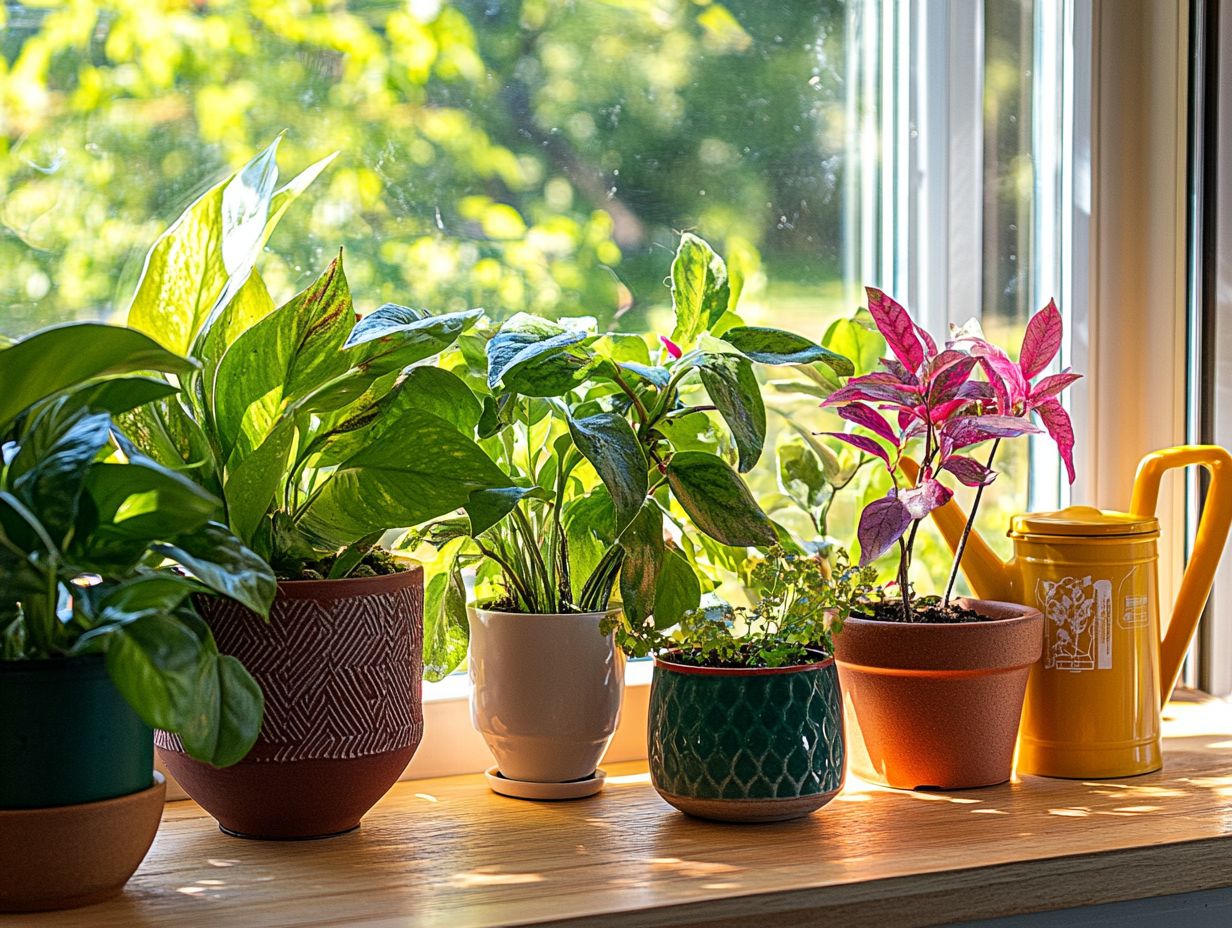
Avoid applying fertilizer to newly transplanted plants. This allows their roots to establish in fresh potting soil.
Fertilizing too soon can disrupt the roots and compromise plant health. Introducing fertilizers too soon can overwhelm your newly transplanted plants with nutrients, upsetting the delicate balance they need to thrive.
Focus instead on soil amendments that enhance soil quality without the risks tied to chemical fertilizers. Compost is an excellent alternative, enriching the soil with organic matter, improving water retention, and providing a slow release of nutrients.
By incorporating compost, such as compost tea, in the early stages of plant care, you create an optimal environment for robust root systems to flourish while minimizing stress on your newly introduced plants.
8. Fertilize During the Plant’s Active Growth Period
Timing your fertilization during your plants’ active growth period is essential for maximizing nutrient uptake and ensuring robust growth. By understanding the specific growth cycles of your indoor plants, you can optimize your fertilizing schedule.
Typically, your indoor plants will thrive most vigorously in the spring and summer months when daylight hours are longer and temperatures are warmer. Look for signs of active growth, such as new leaf development, increased watering needs, or flowering activity.
When you notice these indicators, it s crucial to adjust your fertilization practices accordingly, especially for houseplants. Using a balanced fertilizer in higher concentrations during these peak growth periods can lead to flourishing plants.
As fall and winter approach and many plants enter a dormant phase, it s important to reduce fertilizer quantities to prevent root burn and nutrient imbalance.
9. Water Plants Before and After Fertilizing
Watering your plants adequately before and after fertilizing is crucial for enhancing nutrient uptake and promoting overall plant health. When your plants are well-hydrated, their ability to absorb essential nutrients improves, helping to prevent fertilizer burn.
This practice flushes the soil, creating an inviting environment for nutrient movement while minimizing the risk of root damage. Ideally, water your plants a day or two before applying any fertilizer, allowing the soil to retain moisture for effective nutrient penetration.
After fertilizing, an extra watering can help distribute those nutrients evenly throughout the soil. Techniques such as deep watering encourage roots to grow deeper, giving them better access to both water and nutrients.
You ll see stunning growth that makes your garden the talk of the neighborhood! It’s essential to consider your watering frequency and adjust accordingly.
10. Use Organic Fertilizers
Opting for organic fertilizers like compost and compost tea can significantly elevate the health and sustainability of your indoor gardening endeavors. These natural choices enrich the soil and provide essential nutrients, fostering a balanced ecosystem for your plants. They are ideal for potted plants.
Organic fertilizers also promote the activity of tiny organisms in the soil, enhancing nutrient availability and improving soil structure over time. They reduce the risk of chemical runoff and contamination, making them safer for both you and the environment. Remember, organic fertilizers offer a balanced blend of nitrogen, phosphorus, and potassium essential for plant health.
When you choose organic fertilizers, you re not merely feeding your plants; you re nurturing the entire soil ecosystem. This sustainable approach produces vibrant, resilient plants and contributes to the preservation of biodiversity in your indoor gardening space.
What Are the Signs of Overfertilization?
Recognizing the signs of overfertilization is crucial for maintaining your indoor plants’ health. You might notice symptoms like yellowing leaves and burnt tips, which indicate nutrient imbalances and deficiencies. A common mistake is to overlook these early signs, which can stress your plants.
Your plants may also exhibit stunted growth or a weak appearance, which can be distressing for any plant enthusiast. Act quickly, as prolonged exposure to excessive fertilizers can lead to root burn, compromising your plant s ability to absorb water and nutrients effectively.
To address overfertilization, one effective strategy is to flush the soil with water, helping to remove excess nutrients. This practice is essential for maintaining a healthy balance of plant nutrients. Another tip is to let your plant recover by relocating it to a suitable environment one that s free from additional fertilizer until it shows signs of improvement.
How Can You Revive an Overfertilized Plant?
Reviving an overfertilized plant requires your immediate attention. Identifying the issue early and adjusting your fertilizing schedule can significantly aid in the recovery process.
To start, flushing the soil is essential. Run copious amounts of water through the pot to leach out excess salts that can harm the roots. After that, reassessing your watering habits is crucial. Ensure your plant receives the right amount of moisture to thrive without adding to the fertilizer buildup.
For particularly affected specimens, repotting into fresh, nutrient-free soil may be necessary. Using a fresh potting mix can provide them with a fresh start and improve drainage. If you notice leaf tips browning or yellowing, take these steps seriously; they are essential for revitalizing your precious green companion.
What Are the Benefits of Using Organic Fertilizers?
Utilizing organic fertilizers offers a wealth of benefits, including enhanced soil health, improved plant nutrition, and sustainable gardening practices. These natural options deliver essential nutrients without harmful side effects often associated with chemical fertilizers.
Enriching your soil with organic matter encourages the growth of beneficial microorganisms, which improve nutrient cycling and enhance soil structure. This results in healthier plants that are better equipped to fend off pests and diseases, reducing your reliance on harmful pesticides.
Organic fertilizers also promote a balanced ecosystem in your garden, fostering biodiversity and improving water retention in the soil. By choosing organic gardening, you re not just nurturing your plants you re playing a vital role in safeguarding the environment for future generations. Making this commitment benefits both your personal well-being and ecological sustainability.
Take action today to elevate your gardening game by using organic fertilizers!
How Often Should You Fertilize Indoor Plants?
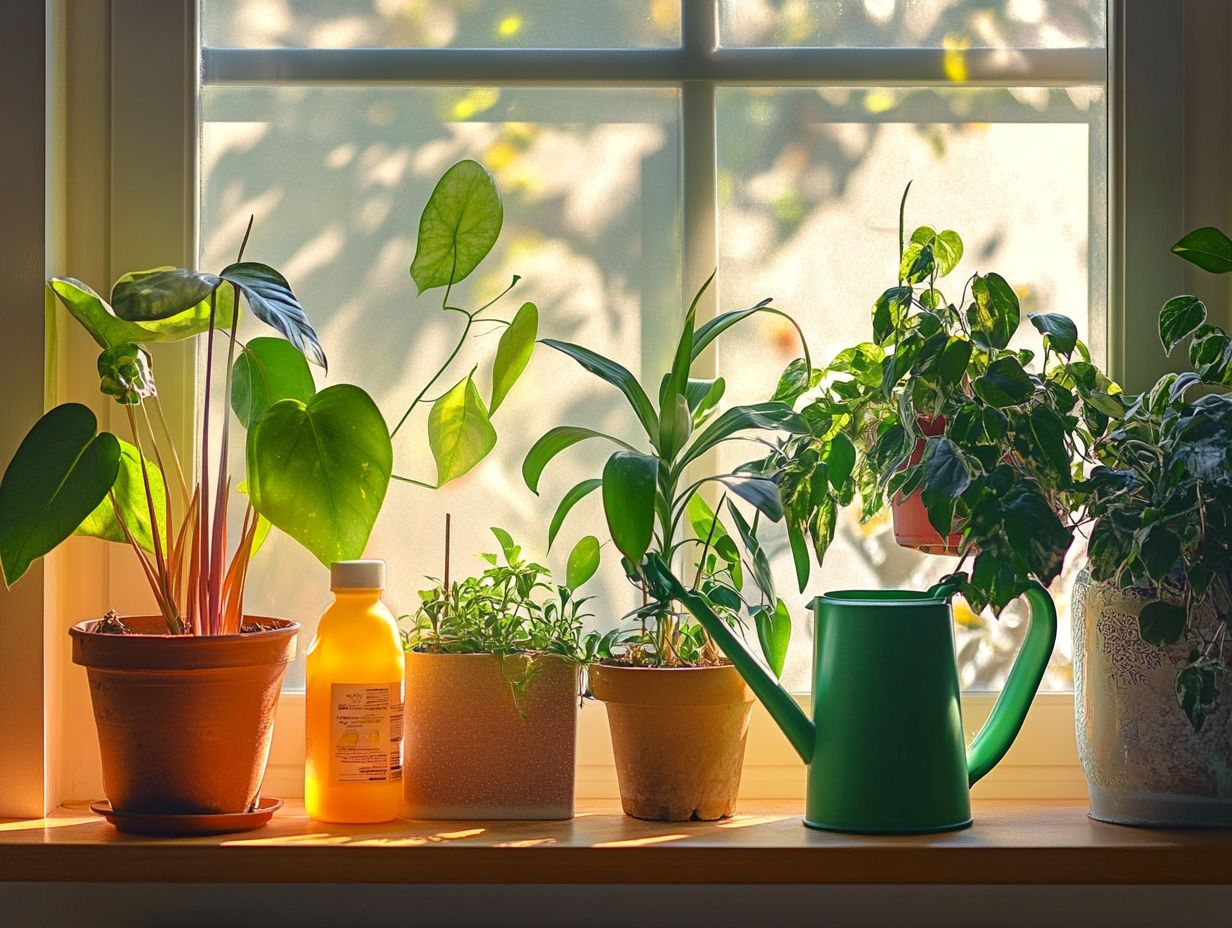
Determining how often you should fertilize your indoor plants is crucial for establishing a balanced schedule. This schedule caters to the specific needs of each plant species.
Timing and frequency will vary depending on seasonal growth patterns and the care regimen you follow. For example, some tropical plants may flourish with bi-weekly fertilization during their active growth phase.
Others might prefer monthly applications. Consider factors such as the species and its unique nutritional requirements.
Think about the current growth stage whether it s a seedling, a mature plant, or one gearing up for dormancy as well as environmental conditions like light, humidity, and temperature.
By understanding these variables, you can tailor your feeding practices. This ensures that each of your indoor plants receives the right balance of nutrients to thrive in its own unique environment.
Can You Make Your Own Fertilizer at Home?
Imagine making your own fertilizer at home! It s easy and fun. It s a great way to meet your indoor plants’ specific nutrient needs while promoting sustainability.
Homemade solutions, like compost, can be customized to deliver essential nutrients tailored precisely to your plants’ growth requirements. This practice minimizes waste.
You can utilize organic materials that are typically at your fingertips, such as kitchen scraps or yard waste. For instance, just toss in some vegetable peels and coffee grounds to create compost that is full of nutrients.
Consider methods like worm composting, where worms break down organic matter to yield powerful fertilizer known as worm castings.
While store-bought fertilizers may seem convenient, they often contain synthetic chemicals. These can harm the environment and disrupt the natural soil ecosystem.
By opting for homemade alternatives, you embrace eco-friendliness and enhance your plants’ natural vitality effectively.
What Are the Different Types of Fertilizers and Their Uses?
Understanding the various types of fertilizers is crucial for effective plant care. This helps you optimize nutrient uptake in your indoor plants.
You have a range of options, including organic fertilizers, chemical fertilizers, and customized solutions designed for your plants’ unique needs.
Each category serves distinct purposes and comes with its own advantages and limitations.
Organic fertilizers, sourced from natural materials like compost or manure, release nutrients gradually. They enrich soil health over time and are particularly suited for plants that thrive in a more natural environment.
On the other hand, chemical fertilizers deliver an immediate nutrient boost. They often contain precise ratios of nitrogen, phosphorus, and potassium to encourage rapid growth.
However, their synthetic nature can lead to issues like nutrient runoff and excess salt buildup. This may not be ideal for all indoor plants.
As a discerning plant enthusiast, weigh both options carefully. Determine the most appropriate solution for your specific greenery, considering factors like plant growth and individual needs.
Start experimenting with your indoor plants today, and share your experiences!
What Are Some Common Mistakes to Avoid When Fertilizing Indoor Plants?
Identifying common mistakes when fertilizing indoor plants is essential for ensuring their long-term health and preventing nutrient deficiencies. Misinterpreting application ratios and overlooking seasonal changes can influence successful fertilization. Understanding your watering frequency is crucial.
A frequent blunder is over-fertilizing, which can lead to nutrient burn, damaging delicate roots and stifling growth. To avoid this, adhere to the recommended dosages on product labels and consider diluting fertilizers during active growth periods.
Using the wrong type of fertilizer can also hinder a plant’s ability to thrive. It’s vital to choose formulations tailored to specific plants, especially those requiring higher phosphorus levels for blooming. For example, when caring for orchids, you might want to consider 5 expert tips for watering orchids indoors. Consistently monitoring your plants for signs of distress will help you adjust your feeding routine, promoting a healthier indoor garden.
What Are Some Natural Alternatives to Chemical Fertilizers?
Exploring natural alternatives to chemical fertilizers can enhance your indoor gardening experience while supporting sustainable practices. Organic fertilizers and compost nourish your plants without the drawbacks of chemical solutions.
These methods deliver essential nutrients, enhance soil structure, boost microbial activity, and reduce the risk of harmful runoff. Utilizing materials like worm castings, fish emulsion, and bone meal provides a nutrient-rich boost to your plants’ health.
Incorporating green manures and mulch can further enrich your soil while minimizing water evaporation. By embracing these eco-friendly practices, you cultivate vibrant plant life and contribute to a healthier ecosystem, all while reducing your carbon footprint.
How Can You Tell If Your Indoor Plant Needs Fertilizer?
Recognizing when your indoor plants need fertilizer is crucial for maintaining their health and ensuring optimal growth. Signs of nutrient deficiencies include pale or yellowing leaves and stunted growth, indicating it’s time to boost your fertilizing schedule.
Other indicators include slower-than-usual growth and a lack of new leaves, which suggest nutrient shortages. Monitor your plants’ health by checking the soil’s moisture and texture; overly dry or compacted soil can hinder nutrient uptake.
If yellowing leaves persist despite regular watering, it s a strong indication that your plant could benefit from a nitrogen boost. Each plant species has unique requirements, so understanding their specific needs enables you to provide effective care.
What Are the Nutrients Essential for Indoor Plant Growth?
Understanding the essential nutrients for indoor plant growth is vital for anyone looking to cultivate healthy, thriving plants. Key nutrients like nitrogen, phosphorus, and potassium play important roles in various processes that contribute to overall plant health.
Nitrogen promotes lush, green leaves; it’s a key component of the green pigment that helps plants make food. Phosphorus supports robust root development and flowering, ensuring your plants grow and reproduce effectively. Meanwhile, potassium regulates water and enhances disease resistance, helping your plants withstand environmental stresses.
To ensure these nutrients remain available, conduct regular soil testing (checking the soil to see what nutrients it has), use balanced fertilizers, and recognize your plants’ specific needs to create ideal conditions for a vibrant indoor ecosystem.
Frequently Asked Questions
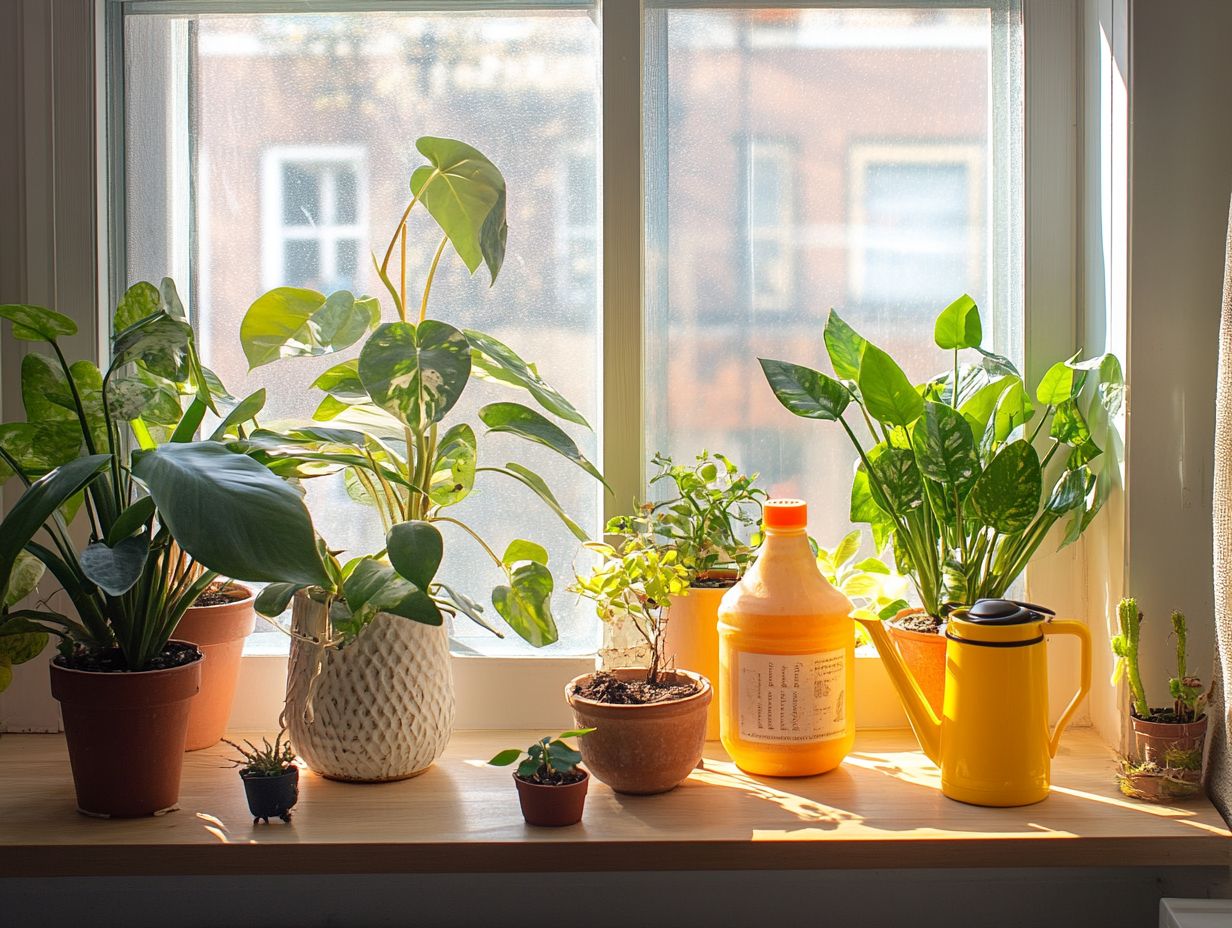
What are the benefits of fertilizing indoor plants?
Fertilizing indoor plants offers essential nutrients. This leads to healthier, more vibrant foliage, flowers, and fruit.
When is The Best Time to Fertilize Indoor Plants?
The ideal time to fertilize is during the active growing season, typically in spring and summer.
How often should I fertilize my indoor plants?
Fertilizing every 2-4 weeks during the growing season is a general guideline. However, individual plant needs may vary.
Can I use outdoor plant fertilizer on indoor plants?
Outdoor fertilizers can be too strong for indoor plants. Always use fertilizers made specifically for indoor varieties.
What kind of fertilizer should I use for my indoor plants?
Choose the right fertilizer for your indoor plants. Options include liquid, solid pellets, and organic types.
Are there any tips for using fertilizer on indoor plants?
Here are some tips:
- Always dilute liquid fertilizers with water.
- Avoid applying them directly on leaves or stems.
- Don t over-fertilize.

